Frank's travels around Britain 2007.
Wiltshire.
I stayed in the M4 service station at Leigh Delamere run by M&S, this and the
villages of Lacock & Castle Combe are in Wiltshire, but Bath certainly isn't!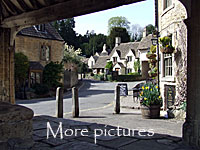
 The
city is founded around the only naturally occurring hot springs in the United
Kingdom. It was first documented as a Roman spa, although tradition suggests
that it was founded earlier. The archaeological evidence shows that the site of
the Roman Baths' main spring was treated as a shrine by the Celts, and dedicated
to the goddess Sulis. The Romans probably occupied Bath shortly after their
invasion of Britain in 43 AD. They knew it as Aquae Sulis (literally "the
waters of Sulis"), identifying the goddess with Minerva. In Roman times the
worship of Sulis continued and messages to her scratched onto metal have been
recovered from the Sacred Spring by archaeologists. These are known as curse
tablets. These curse tablets were written in Latin, and usually laid curses on
other people, whom they feel had done them wrong. For example, if a citizen had
his clothes stolen at the Baths, he would write a curse on a tablet, to be read
by the Goddess Sulis, and also, the "suspected" names would be mentioned.
The
city is founded around the only naturally occurring hot springs in the United
Kingdom. It was first documented as a Roman spa, although tradition suggests
that it was founded earlier. The archaeological evidence shows that the site of
the Roman Baths' main spring was treated as a shrine by the Celts, and dedicated
to the goddess Sulis. The Romans probably occupied Bath shortly after their
invasion of Britain in 43 AD. They knew it as Aquae Sulis (literally "the
waters of Sulis"), identifying the goddess with Minerva. In Roman times the
worship of Sulis continued and messages to her scratched onto metal have been
recovered from the Sacred Spring by archaeologists. These are known as curse
tablets. These curse tablets were written in Latin, and usually laid curses on
other people, whom they feel had done them wrong. For example, if a citizen had
his clothes stolen at the Baths, he would write a curse on a tablet, to be read
by the Goddess Sulis, and also, the "suspected" names would be mentioned.
The
waters from its spring were believed to be a cure for many afflictions. In 1668
Thomas Guidott moved to Bath and set up his practice there. He was a student of
chemistry and medicine at Wadham College Oxford. He became interested in the
curative properties of the waters and in 1676 he wrote A discourse of Bathe,
and the hot waters there. Also, Some Enquiries into the Nature of the water.
This brought the health-giving properties of the hot mineral waters to the
attention of the country and soon the aristocracy started to arrive to partake
in them. From Elizabethan to Georgian times it was a resort city for the
wealthy. As a result of its popularity during the latter period, the city
contains many fine examples of Georgian architecture, most notably the Royal
Crescent. The city has a population of over 80,000 and is a World Heritage Site.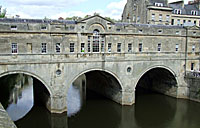
Around 1770 the eminent neoclassical architect Robert Adam designed Pulteney Bridge, using as the prototype for the three-arched bridge spanning the Avon an original, but unused, design by Palladio for the Rialto Bridge in Venice. Thus, Pulteney Bridge became not just a means of crossing the river, but also a shopping arcade. Along with the Rialto Bridge, is one of the very few surviving bridges in Europe to serve this dual purpose. It has been substantially altered since it was built. The bridge was named after Frances and William Johnstone Pulteney, the owners of the Bathwick estate for which the bridge provided a link to the rest of Bath. About 20 years before, I had purchased a Roman coin from a shop on the bridge. The shop is still there ... but no roman coins seem to be in evidence.
 "The
Circus" is one of the most splendid examples of town planning in the city. Three
long, curved terraces designed by the elder John Wood form a circular space or
theatre intended for civic functions and games. Wood never lived to see his
unique example of town planning completed, as he died five days after personally
laying the foundation stone on May 18, 1754. The best known of Bath's terraces
is the Royal Crescent, built between 1767 and 1774 and designed by the younger
John Wood. But all is not what it seems; while Wood designed the great curved
facade of what appears to be about 30 houses with Ionic columns on a rusticated
ground floor, that was the extent of his input. Each purchaser bought a certain
length of the facade, and then employed their own architect to build a house to
their own specifications behind it; hence what appears to be two houses is
sometimes one. This system of elegant town planning is betrayed at the rear of
the crescent: while the front is completely uniform and symmetrical, the rear is
a mixture of differing roof heights, juxtapositions and fenestration. This "all
to the front and no rear" architecture occurs repeatedly in Bath.
"The
Circus" is one of the most splendid examples of town planning in the city. Three
long, curved terraces designed by the elder John Wood form a circular space or
theatre intended for civic functions and games. Wood never lived to see his
unique example of town planning completed, as he died five days after personally
laying the foundation stone on May 18, 1754. The best known of Bath's terraces
is the Royal Crescent, built between 1767 and 1774 and designed by the younger
John Wood. But all is not what it seems; while Wood designed the great curved
facade of what appears to be about 30 houses with Ionic columns on a rusticated
ground floor, that was the extent of his input. Each purchaser bought a certain
length of the facade, and then employed their own architect to build a house to
their own specifications behind it; hence what appears to be two houses is
sometimes one. This system of elegant town planning is betrayed at the rear of
the crescent: while the front is completely uniform and symmetrical, the rear is
a mixture of differing roof heights, juxtapositions and fenestration. This "all
to the front and no rear" architecture occurs repeatedly in Bath.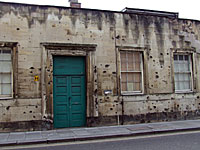
Between the evening of 25 April and the early morning of 27 April 1942 Bath was subjected to three air raids by the Luftwaffe in reprisal for RAF raids on the German cities of Lübeck and Rostock. The three raids formed part of the Luftwaffe campaign popularly known as the Baedeker Blitz and damaged or destroyed more than 19,000 buildings and killed more than 400 people. Considerable damage was done to noteworthy historical buildings. Houses in the Royal Crescent, Circus and Paragon were burnt out as were the Assembly Rooms while the south side of Queen Square was destroyed. All have since been reconstructed.
Historically part of the county of Somerset, Bath was made a county borough in 1889, and has been independent of Somerset county council control ever since. Bath came into Avon when that non-metropolitan county was created in 1974. Since the abolition of Avon in 1996, Bath has been the main centre of the unitary authority of Bath and North East Somerset (B&NES). Bath remains, however, in the ceremonial county of Somerset. (Talk about complicated!).
Bath is a truly beautiful city, full of elegant & faded architecture. A high class, expensive centre for the arts and steeped in history. Never miss a chance to wander round is fascinating steep streets. Then step back further in time & visit Lacock!
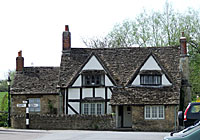 Lacock
is 3 miles (5 km) from the town of Chippenham. The history of Lacock Village is
very much linked to that of the Abbey. The village dates back to the 13th
century. Lacock developed a thriving wool industry during the Middle Ages.
Together with the Abbey, the village was given to the National Trust in 1944 by
Matilda Talbot (wife of the famous pioneer photographer, William Henry Fox
Talbot) and attracts many visitors by virtue of its unspoiled appearance. A
country house was created out of the medieval abbey, and became Talbot's
home.
Lacock
is 3 miles (5 km) from the town of Chippenham. The history of Lacock Village is
very much linked to that of the Abbey. The village dates back to the 13th
century. Lacock developed a thriving wool industry during the Middle Ages.
Together with the Abbey, the village was given to the National Trust in 1944 by
Matilda Talbot (wife of the famous pioneer photographer, William Henry Fox
Talbot) and attracts many visitors by virtue of its unspoiled appearance. A
country house was created out of the medieval abbey, and became Talbot's
home.

Most of the houses are 18th century or earlier in construction. There is a 14th century tithe barn, a medieval church, and an inn dating from the 15th century and an 18th century lock-up. The village has been used as a film and television set, notably for the 1995 BBC production of Pride and Prejudice and the Harry Potter movies. Without doubt, you realise you are actually in a film set. As I walked round, they were setting up to start shooting a film starring Judi Dench. Americans wander round thinking this is really what England is like. Young ladies dress up in Victorian clothes to serve lovely snacks. (she said that Tuesdays & Wednesdays were the days to pick, as its quieter then) Of course nothing is cheap. The cost of staffing places, repairing Grade 1 listed buildings & a short season make sure of that. The Abbey is over £8 to visit, so I didn't venture in! Never-the-less, a truly lovely place, held in aspic for the world to enjoy at no cost to walk around.
But then there is Castle Combe! Known for its motor racing circuit, Castle Combe village is just down the hill in a pretty valley.
 Described
as English prettiest village, everything palls into insignificance after this
place. Visit this last & go back with a smile on your face, full of contentment
that there are still places like this to see.
Described
as English prettiest village, everything palls into insignificance after this
place. Visit this last & go back with a smile on your face, full of contentment
that there are still places like this to see.
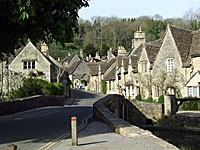
Castle Combe’s history goes back to the site of a Mott & Bailey castle which is above today’s village, little more than earthworks now mark its one time presence. Originally it was a British hill fort, which became occupied by the Romans due to its proximity to The Fosse Way. After the Romans, came the Normans, who built the fort up into a Castle. By the middle ages the village in the valley had become an important centre for the wool industry. The spinsters and weavers lived in the cottages (hence names such as "Weaver’s House") and the river, still known as By Brook, provided the power to run the mills.
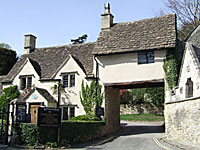 The village
houses are all of typical Cotswold type, constructed in stone with thick walls
and roofs made from split natural stone tiles. The properties are many hundreds
of years old and are listed as ancient monuments. For many years
things changed very slowly. Walter De Dunstaville (1270) whose family owned the
Castle after the Norman conquest, has his tomb in the church. Later, the Scrope
family moved in as Lords of the manor and stayed for nearly 500 years. In 1947
the whole village was put up for auction by the Lord of the Manor.
Strict rules apply to preserve the beauty and character of Castle Combe for
later generations to admire. The village is built around the 14th-century Market
Cross with the old water pump beside it. A few yards away are the remains of the
Butter Cross which was dismantled during the 19th century. St. Andrew's Church
is probably 12th century and of particular interest inside is the modified
15th-century clock which used to ring the hours from the tower. The
wondrous fact is, that this is still a living village. I guess many of the houses
are used as rental cottages but never-the-less it is still not National Trust. A
truly stunning village with a will to keep it preserved as it was. The parking
is up above the village. There is very little parking in the centre & therefore
the photographs are nearly car free.
The village
houses are all of typical Cotswold type, constructed in stone with thick walls
and roofs made from split natural stone tiles. The properties are many hundreds
of years old and are listed as ancient monuments. For many years
things changed very slowly. Walter De Dunstaville (1270) whose family owned the
Castle after the Norman conquest, has his tomb in the church. Later, the Scrope
family moved in as Lords of the manor and stayed for nearly 500 years. In 1947
the whole village was put up for auction by the Lord of the Manor.
Strict rules apply to preserve the beauty and character of Castle Combe for
later generations to admire. The village is built around the 14th-century Market
Cross with the old water pump beside it. A few yards away are the remains of the
Butter Cross which was dismantled during the 19th century. St. Andrew's Church
is probably 12th century and of particular interest inside is the modified
15th-century clock which used to ring the hours from the tower. The
wondrous fact is, that this is still a living village. I guess many of the houses
are used as rental cottages but never-the-less it is still not National Trust. A
truly stunning village with a will to keep it preserved as it was. The parking
is up above the village. There is very little parking in the centre & therefore
the photographs are nearly car free.
Links for information on this page:
